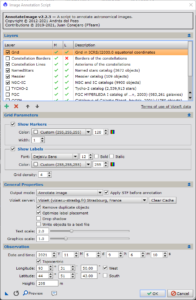When creating large astrophotography mosaic, utilizing multiple horizontal and vertical panels, the integration process requires identifying a few parameters
- Coordinates: A rough estimate of the final mosaic’s central right ascension and declination coordinates.
- Mosaic Dimensions: Based on the scale of each panel, estimate the final dimensions of the integrated image.
Unsure of the mosaic processing order? Use the Mosaic Workflow for Astrophotos
Image Annotation Script
The Image Annotation Script is different than the Annotation process. Annotation lets you manually place objects onto the image. The Image Annotation Script automatically places grids, names, patterns onto the image.
As part of the annotation process, the coordinates of the image must be part of the FITS header of the center-most mosaic panel. This is obtained by using the Image Plate Solver script. This information will allow the annotation script to apply a right ascension and declination grid onto a copy of the image.
Make sure your image is open and then launch the Annotation Script (Scripts – Render – Annotate Image).
Depending on the overall resolution of the image, the text for the grid values might be too small. To modify, select the Grid row in the Layers section and increase the Show Labels: Font value. Once complete, hit OK to generate the image.
Find Center of Mosaic
The result of the annotation script is a new image with a grid pattern applied. You can use this to find the coordinates of the center of your mosaic.
This particular mosaic is 4 panels wide and 2 panels tall. Based on the layout, the center of my mosaic is the bottom-right section of this image. The rough coordinates are:
- RA: 6:32
- Dec: 5:02
If the mosaic is 3 panels wide and 1 panel tall, the coordinates would be in the center of the center image.
Mosaic Dimensions
In addition to the center point, a rough estimate of the the overall size of the mosaic must be identified. The dimensions of the active image are available on the bottom status bar within PixInsight (enable by selecting View – Tool Bars – Information).
For example, if an image is 4537 pixels wide and 3450 pixels tall, it would yield the following rough dimensions:
- Wide: 4537*4 = 18,148 pixels
- Height: 3450*2 = 6,900 pixels
However, these numbers assume each panel has no overlap and no rotation. To account for this, it is best to add a sizable buffer to avoid losing any edges.
Wide: 4537*4 = 18,148 pixels = 20,000 pixels
Height: 3450*2 = 6,900 pixels = 10,000 pixels
What’s Next
If following the Mosaic Workflow for Astrophotos, the was image solved, the center coordinates were identified, and the overall size of the final mosaic was calculated. This information is used to a catalog of stars that is used for star alignment of each mosaic panel.

